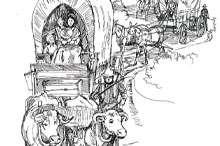No products in the cart.
Backwards on Goodale’s Cutoff

Early Cattle Drives through Idaho
By Billy Jim Wilson
In 1879, the year after the Bannock War that pitted U.S. troops against Bannock warriors of southern Idaho and Paiutes of northern Nevada, cattlemen in eastern Oregon began to see the profit to be made from trail drives that crossed Idaho. Some half-dozen herds left that year en route to Wyoming, and one of them was captained by a first cousin to my grandfather, Leonard William “Pete” Wilson. That first cousin’s name was William H. Daughtrey.
At the time, ranchers had a minimal market in the Northwest for their cattle, but Wyoming had lots of range, a market in the East via the new railroad, and not enough cattle to supply the demand. The old cattle drives from Texas to Kansas and points west are relatively famous nowadays, but I’ll wager fewer people are aware that a large percentage of the cattle in Wyoming came through Idaho from eastern Oregon and Washington.
“Although there were several herds of cattle brought to Wyoming from Oregon prior to 1880, the real influx from the Northwest came after the treaty with the Sioux, that is to say, after the Indian wars of 1876 and 1877, and after the battle of the Little Big Horn.” That’s from what is probably the definitive book on this phenomenon, Wyoming Cattle Trails: History of the Migration of Oregon-Raised Herds to Midwestern Markets, by John K. Rollinson & E. A. Brininstool, published by Caldwell’s Caxton Printers, circa 1948.
This content is available for purchase. Please select from available options.
Register & Purchase Purchase Only
Register & Purchase Purchase Only

